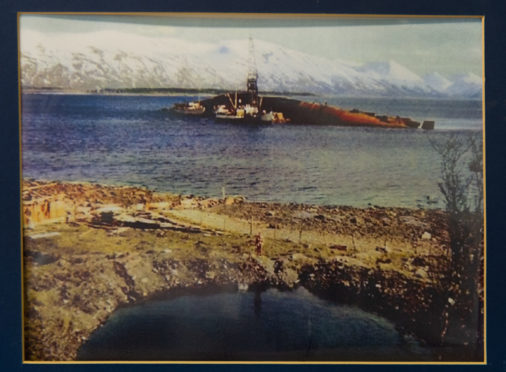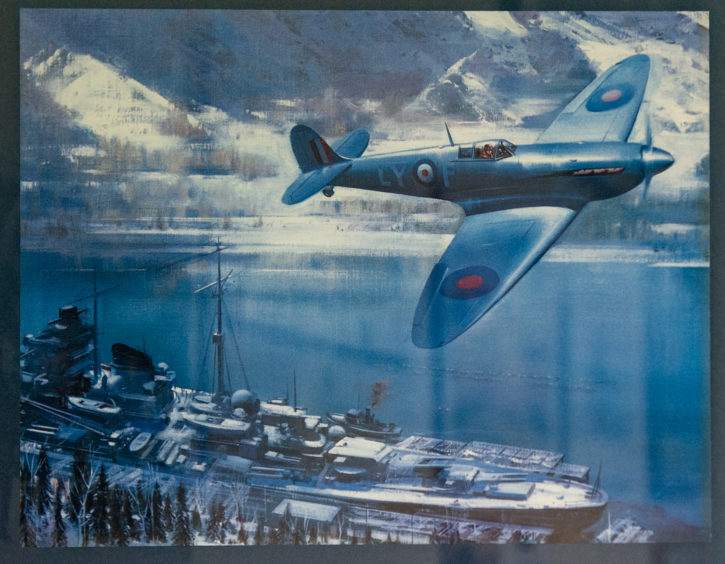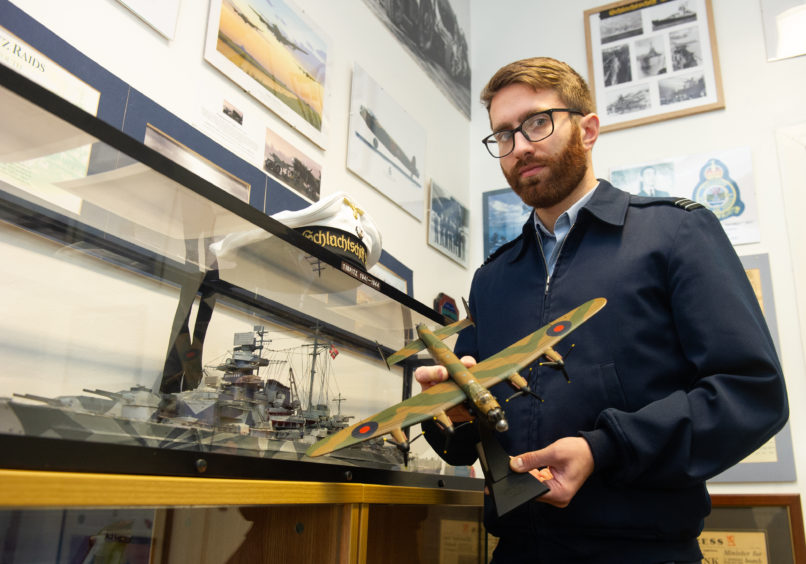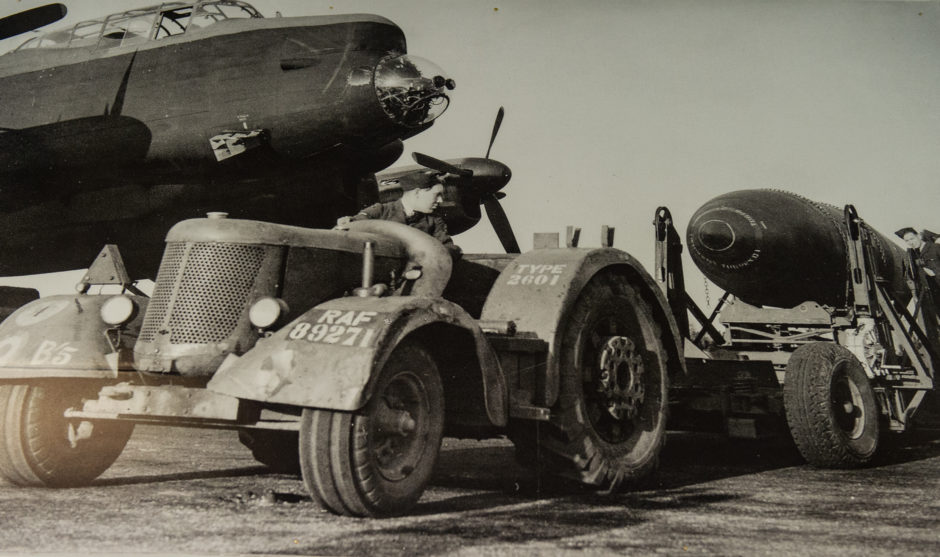Seventy-five years on, Rachel Lee explores the ‘brutally short’ career of Hitler’s most fearsome battleship and how, on one crisp November morning, planes set out from three Moray bases to sink her
Stepping out one by one, boots crunching on the frosty ground and their breath thick in the bitter winter air of the early hours of the morning, the brave fighters of the 617 and IX Squadron set off on their mission.
Following several cancellations caused by bad weather, Operation Catechism was finally underway on a chilly November 12, 1944.
Its sole objective was to defeat one of Hitler’s most powerful and most devastating battleships, the Tirpitz, once and for all.
Shortly after the clock struck 3am – having laboriously thawed the wings of the aircraft – 32 Lancaster bombers, sent from across the UK to the RAF’s Lossiemouth, Kinloss and Milltown bases, departed, their bellies filled with 12,000 pound ‘Tallboy’ bombs.
They were to attack the sea fortress – nicknamed “the beast” by Winston Churchill – at an anchorage near the Norwegian city of Tromso.
Over the previous three years and 33 missions, an incredible 700 aircraft had tried and failed to destroy the Tirpitz as it terrorised the allied fleet and its convoys.
But the crews that flew out from the Scottish bases succeeded in ending its reign of terror without the loss of a single bomber .
The “coup de grace” was delivered from Moray as the Lancasters landed two direct hits, their bombs punching through its armour.
The battleship capsized just minutes after being hit.
Upon looking down at the upturned hull, described as appearing like “a silver island”, one Lancaster crew member let out a sigh of relief and uttered: “Thank god for that, it’s the last time we’ve got to come here”.
Today marks the 75th anniversary of that successful mission and the valiant actions of the 617 and IX Squadron crew.
Their triumphant operation against one of the most formidable threats to the Royal Navy and the Royal Air Force’s defence of Great Britain during the Second World War was one of many keys to the fall of the Nazis the following year.
And the Moray bases at Lossiemouth, Kinloss and Milltown were vital to the success of Operation Catechism.
With their optimal location and clear skies, the northern bases gave the aircraft fighters a much-needed advantage over one of the largest and most heavily armed battleships in European history.
This was to be the third and final mission undertaken from the Moray bases, following September’s Operation Paravane and the later attack on October 29, Operation Obviate.
Former head of Defence and International Affairs at RMA Sandhurst, John Sweetman, researched the mission to sink the Tirpitz for three years as he compiled his comprehensive book, ‘Tirpitz: Hunting the Beast’.
He believes that had fleet air arm crews of 617 and IX Squadron not succeeded in their operation on this day, 75 years ago, the German battleship would have “caused havoc in the Atlantic” and had an major impact on the outcome of the war.
Mr Sweetman said: “I can’t emphasis enough the importance of the final RAF raids and I think the role of Scotland in the attacks on the Tirpitz, both from the naval and air force point of view, has been underestimated.”
Mr Sweetman had previously written a book on the 617 Squadron, known as “the Dambusters”, which sparked an interest in the sinking of the Tirpitz.
On a trip to Lossiemouth from his home in Portsmouth for the 60th anniversary of the Dambusters raid, Mr Sweetman met two of the courageous flyers who flew in Operation Catechism, Robert Knights and Tony Iveson, who “were very keen that the fleet air arm story should be told”.
He added: “It was a great privilege to be able to talk to the people who undertook this mission during the war.”
“It was enormously brave and I remember feeling so full of admiration for them.”
During this visit, Mr Sweetman stopped by RAF Lossiemouth’s heritage centre to view its extensive memorial to the Tirpitz.”
Flight Lieutenant Daniel Chorley, communications officer for RAF Lossiemouth, can often be found at the heritage centre.
He said: “On the 75th Anniversary of Operation Catechism, it’s a poignant time to reflect on the sacrifices that were made around the country as part of the allied effort.
“Many of the famous battles and operations focus on activities in the south of England, but the Tirpitz is a reminder of the war effort launched in Scotland.”
The Tirpitz: Germany’s ‘beast’ on the high seas
- September 1, 1939: Britain and France declare war on Germany after the Nazis invade Poland – the start of the Second World War.
- February 25, 1941: The second of two Bismarck-class war ships built for the Kriegsmarine, Nazi Germany’s Navy force of the Second World War, is unleashed.
It bears the name of the founder of the Nazi’s Imperial Navy, Grand Admiral Alfred von Tirpitz.Following the completion of trials earlier in the years and multiple alterations, she is the heaviest battleship ever produced by a European navy and ready to stalk the European seas.
Its 15in guns were capable of sending shells more than 22 miles and, despite its weight, it had a top speed of 24 knots.
It menaced allied convoys and tied down the British Home Fleet. The simple rumour that it was “out” was enough was enough to disrupt operations.
So disruptive was she, during “a brutally short career”, Winston Churchill decreed her destruction to be of “supreme importance”.
- August 29, 1944: Goodwood IV was the final in a series of tenacious but ultimately unsuccessful attacks against the Tirpitz by a multitude of Barracudas, Corsairs and Hellcats.
These missions were, however, far from futile as they caused extensive damage and provided vital information.
In particular, it was clear the Allied planes were too slow as the ship would always be lying in wait.
This led to the formation of plans that would eventually bring about its end thanks to the use of the RAF bases at Lossiemouth, Kinloss and Milltown.
- September 15, 1944: Operation Paravane was launched after members of the 617 and IX Squadron travelled from their Lincolnshire bases to Moray.
Lancasters were used to bomb the Tirpitz and while they did not sink it, the battleship was so greatly impaired that it was declared unfit for operations.
- October 29, 1944: At about 1am in the morning, 39 Lancaster aircraft launched from Lossiemouth, Kinloss and Milltown.
Just as their target was in sight, their efforts were blighted by thick, impenetrable cloud and adverse weather conditions.
They dropped ‘Tallboy’ bombs but none connected with the ship.
That day, one of the crew was heard to say: “The luck won’t always favour the Tirpitz, one day you’ll get her.”
- November 5, 1944: The 617 and IX squadrons once again convened at the Moray bases to prepare for a follow-up attack but scrap their plans due to wind, rain and hail.
- November 12, 1944: At 3.25am, the wheels of Operation Catechism are set in motion.
32 Lancaster bombers take off from Lossiemouth, Kinloss and Milltown, following the same route taken on October 29.
Unlike the previous mission, while it was a freezing winter morning, the sky was crystal clear.
The Lancasters dropped 12,000 pound ‘Tallboy’ bombs, resulting in one near-miss but two direct blows to the vessel.
Of the 1,700 crew on board the Tirpitz, 971 were declared lost at sea, most trapped below desks.
No bomber was lost during the attack and most returned home safely.
One of IX planes was so badly damaged by flak from the battleship it was unable to recross the North Sea and instead limped to neutral Sweden, dogged by a German fighter, where it made a forced landing.
A short message was received at RAF Lossiemouth from the AOC 5 Gp: “The job is done. The ship has capsized. Congratulations to all concerned. So much for the Tirpitz!”
- November 13, 1944: The Air Ministry publicly announced that Hitler’s behemoth of the sea had been destroyed.
The news was carried across the UK by newspapers and radio and the heroic aircrews celebrated.
- September 2, 1945; After six years and one day, and tens of millions of lives lost, the war was finally over.



